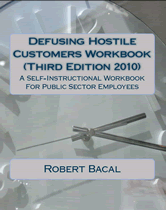
Downsizing
Leading Those That Remain
When this was written, both the City of Winnipeg, and the Manitoba government were working through budgets and estimates. One result was the loss of positions in both domains. This article deals with a critical aspect of downsizing -- turning around the organization and leading those that remain. For more help with leadership issues drop in at the Leadership Help Center.
Downsizing...Right-sizing, lay-offs or workforce adjustment, whatever the current "correct" terminology, the fact remains that it is the most difficult thing that managers will deal with in their careers.
There are two (only two?!) issues regarding downsizing. First, the period of downsizing brings with it incredible anxiety for everyone. Both managers and employees have to "get through" this period where downsizing is announced and individuals are notified. While this is the period of greatest short term stress, it is an acute situation.
The second problem, and one of much more long term significance is the issue of those that remain. Somehow managers have to deal with the fall-out from the downsizing process, and move their organizations beyond the grief, the anger and the loss of morale that characterizes these major organizational events. It is those that remain that will determine what happens to the organization. We are going to talk about the long term issues here.
The First Few Weeks
In the first few weeks after downsizing even those who still have jobs will feel a lot of difficult things. Grief, anger, sense of betrayal, and depression are common "normal" reactions. Typically productivity drops as people work through their feelings by talking with each other.
This applies to you as the leader of your organization. However, as a leader you have an important role to play in helping employees get past the initial reactions.
During this time, it is important that you do not pressure employees unduly, either in the areas of increasing productivity, or in expressing feelings about the change. Some people want to talk, others not. Some will work harder and some will not. Your job is to help by gently talking to them, both in group settings and individually about their reactions, and how you can help.
Listening is key here. Ask questions and keep your own comments to a minimum, and don't exhort or pressure people. By showing concern and interest, you will be working towards repairing the sense of broken trust that accompanies downsizing.
During this period, you need to take stock of your own emotional situation. Your ability to lead people through the tough times will depend on your own physical and emotional health. Try not to cut yourself off. Talking to colleagues outside your organization is a good idea, or at least, venting your own feelings with someone unconnected with your organization. If you find yourself plagued by sleeplessness, mood swings and depression and guilt, don't hesitate to take advantage of support services that are available.
Normalizing
The initial shock of downsizing is likely to linger for some time, certainly for more than the two weeks mentioned. Unfortunately, you and your staff have goals to accomplish, people to serve. At some point there is a need to get on with it, to normalize the situation.
It is difficult for leaders to determine when it is time to start sending the message that "business as usual" must prevail. Too early and you alienate and anger staff...too late and you end up wallowing. It is best to start normalizing slowly and gently.
The situation in your organization can be helped if you start to address any operational problems that might have been caused by the downsizing. Any shifting in staff will result in new challenges in terms of doing business, and there can be some confusion and chaos regarding how you are going to go about doing "business" with a smaller staff complement.
It is important that the chaos be reduced. Normally this will mean clarifying with staff any concerns they have about getting the business done, and problem-solving around the issues. The longer that there is confusion, the more likely there will be permanent effects on organizational health and morale.
During this period, both group problem solving meetings and individual discussions are appropriate and recommended. Bring ALL staff into the discussion, and make sure everyone is clear what they should be doing.
While the feelings of employees are important during this phase, staff need to be slowly moved back to getting the job done. By getting clear understandings of the changes, you will create a climate of stability, which is necessary for the "recovery" of people in the organization.
Futuring
The first part of adjusting to downsizing is to address the feelings of those that remain. The second is to focus on dealing with the operational problems stemming from the changes, and the third step deals with the future.
People need a vision of the future, a sense of what they are trying to achieve, and they also need to know that they are part of a goal-oriented team pulling in the same direction. While we have talked above about "getting through", futuring involves people in trying to create (or confirm) a vision of the organization, and it's goals, values, purpose, etc. It is the creation and commitment to these things that will work to revitalize an organization that has been downsized.
The futuring process is usually a group process, and can extend to undertaking strategic planning, re-examination of priorities, operational planning, and review of role and mission. By doing these kinds of things you promote a sense that the future will bring positive, exciting things. Organizations that have lost staff need to have that sense if they are to rebuild.
Recap
Leading staff through downsizing requires the leader to exercise superior judgement and decision-making. It's a complicated task that involves the leader in recognizing the natural reactions of those that remain in the organization, and determining the right timing for moving the organization from the emotional reactions to a focus on the present and future. While it is difficult, the consequences of mis-managing or under-managing the situation are severe. Both management and staff will suffer if the timing is wrong, or managers deny or avoid dealing with the fall-out from downsizing.





